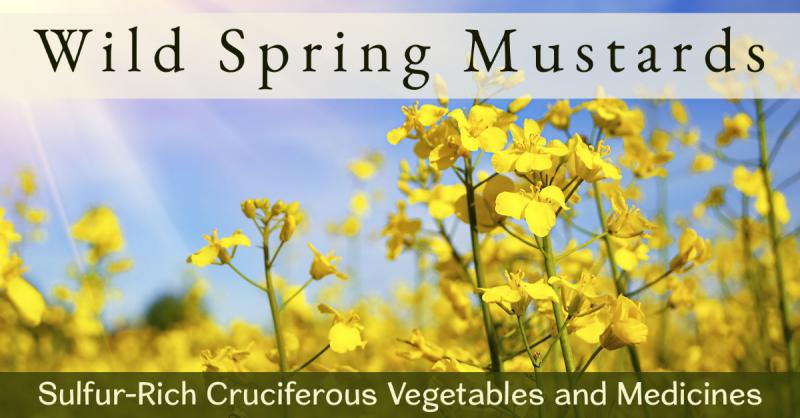
Each spring, I see numerous members of the mustard family (Brassicaceae) present themselves as some of the first herbs of spring. Once you know how to recognize them, you’ll probably notice a lot of them. To start with, I think it is interesting to talk about about the energetics of the mustard family and its relationship to the mineral sulfur.
Sulfur and the Mustard Family
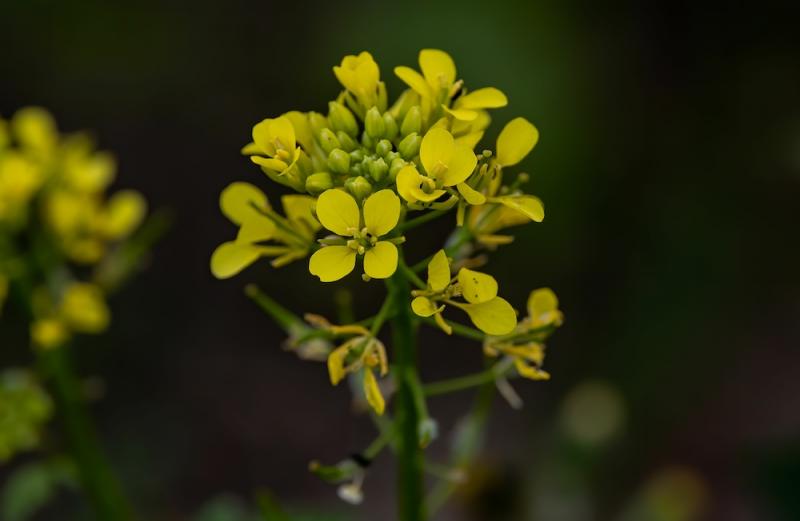 Sulfur is a bright yellow mineral and it is the third most abundant mineral in the human body. It is also the fourth most important mineral for plant growth. Sulfur has a warming quality in living tissue, which is why it is considered a hot element. It also accelerates protein metabolism and growth.
Sulfur is a bright yellow mineral and it is the third most abundant mineral in the human body. It is also the fourth most important mineral for plant growth. Sulfur has a warming quality in living tissue, which is why it is considered a hot element. It also accelerates protein metabolism and growth.
Plants in the mustard family typically contain significant amounts of sulfur compounds, which give them some interesting characteristics. One of these is their rapid germination and growth. Their lives are fast, which is why many of them grow in the early spring and summer, in response to the warming earth. Their lives are rapid; growing quickly, flowering, and producing seeds in a short time span. Their flowers are commonly yellow, bright white, and orange, colors associated with their warm sulfuric nature.
Mustard plants are often very weedy, which is why you might miss seeing them. They will often grow in places other plants won’t, such as near the seashore, high altitudes, deserts, rocky areas, and barren, disturbed soils, sometimes referred to as waste places. There are no highly toxic plants in the mustard family, and many species are either edible or medicinal. In fact, the whole class of vegetables collectively referred to as cruciferous vegetables are from the mustard family. The term cruciferous comes from the former name of this family, Cruciferae.
Health Benefits of Sulfur
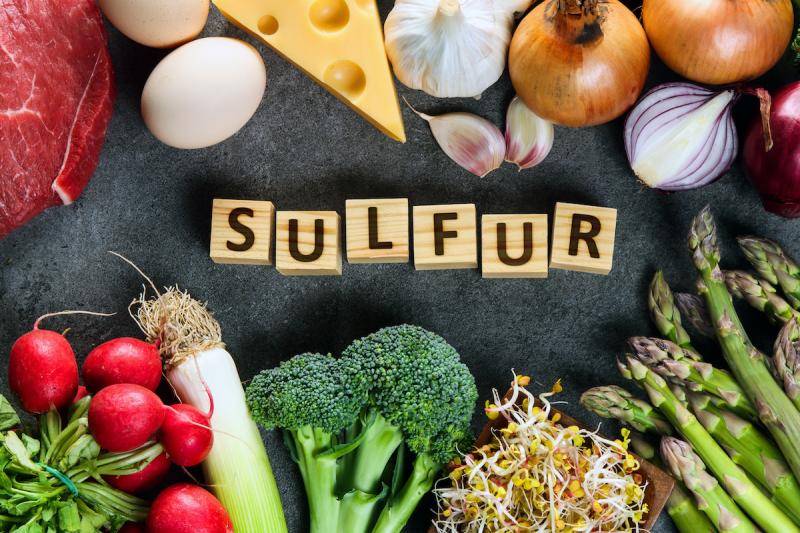 These sulfur-rich plants tend to have some common health-building and healing qualities. First, they tend to aid the digestion and utilization of proteins. I recently covered these benefits in Mustard is More Than a Condiment.
These sulfur-rich plants tend to have some common health-building and healing qualities. First, they tend to aid the digestion and utilization of proteins. I recently covered these benefits in Mustard is More Than a Condiment.
Second, before antibiotics, sulfur drugs were commonly used to fight infections. And because of their sulfur content many of these plants will help the immune system fight infections as well.
Third, sulfation is a major pathway for chemical detoxification. Eating cruciferous vegetables is known to have a protective effect against environmental chemicals and reduces the risk of cancer. It is also the detoxification pathway for many toxic chemicals. Including the chemicals that were involved in the recent Ohio train derailment.
Fourth, sulfur compounds can help reduce inflammation and are useful in easing joint and muscle pain in arthritis, rheumatism, and other forms of chronic pain. Sulfur compounds like MSM, glucosamine sulfate, chondroitin, and SAMe all have this property. People have also sought out sulfur-rich mineral hot sprints for easing chronic pain and inflammation.
Finally, sulfur aids the creation of healthy hair, skin, fingernails, and other tissues. It aids glucose metabolism. It is a component of many vitamins and amino acids and may also help protect the brain from dementia and Alzheimer’s.
Examples of Spring Mustards
Now that you know the benefits of sulfur and the sulfuric nature of mustard plants, let’s look at some of the mustard family plants you might spot this spring. I have routinely nibbled on many of these edible plants, and often suspected some of them have had medicinal qualities. One of the reasons why I’m writing this article is because I recently discovered that many of these plants do in fact have historical and researched medicinal value. So, I want to share some of what I learned with you.
Peppergrass
There are several species of peppergrass that you’ll see as common spring weeds. They belong to the genus Lepidium, which includes maca and garden cress. I spot some peppergrass species every spring and nibble on the unripe fruits (seed pods) growing under the flowers. They’re quite palatable, having a pleasant mustardy flavor.
In Daniel E. Moerman’s book Native American Ethnobotany, eight different species are listed as having been used, mostly as food, by various Native American tribes. Based on their flavor they could be used to season food like mustard, and to aid digestion as well as act as a spring tonic to help clean out the liver. Below are some photos of three species of peppergrass so you can get an idea of what they look like.

White Top
Another member of the Lepidium genus is white top (L. draba), also known as hoary cress. White top also goes by the Latin name Cardaria draba.
This is a highly invasive weed that often grows in patches because it releases chemicals that inhibit the growth of other plants. I’ve nibbled on the flowers, leaves and seed pods of white top. If you want to eat it as a food it’s best to harvest the young greens (before the plant flowers), the flower buds, and the seeds.
However, in further research I learned that white top has been used as medicine. It is anti-inflammatory, expectorant, antimicrobial, and lowers blood sugar. it has been proved that the plant shows an antibacterial activity on Staphylococcus aureus and Bacillus subtilis (Gram-positive) and on Pseudomonas aeruginosa and Escherichia coli (Gram-negative).
There also appear to be cytotoxic compounds in white top. Considering the doctrine of signatures, I think it makes sense that the plant would probably be helpful in both preventing and treating cancer. The plant not only spreads like a tumor, it is also thriving in a toxic world. I personally want to experiment with using this plant for that purpose, as I believe it warrants further investigation.
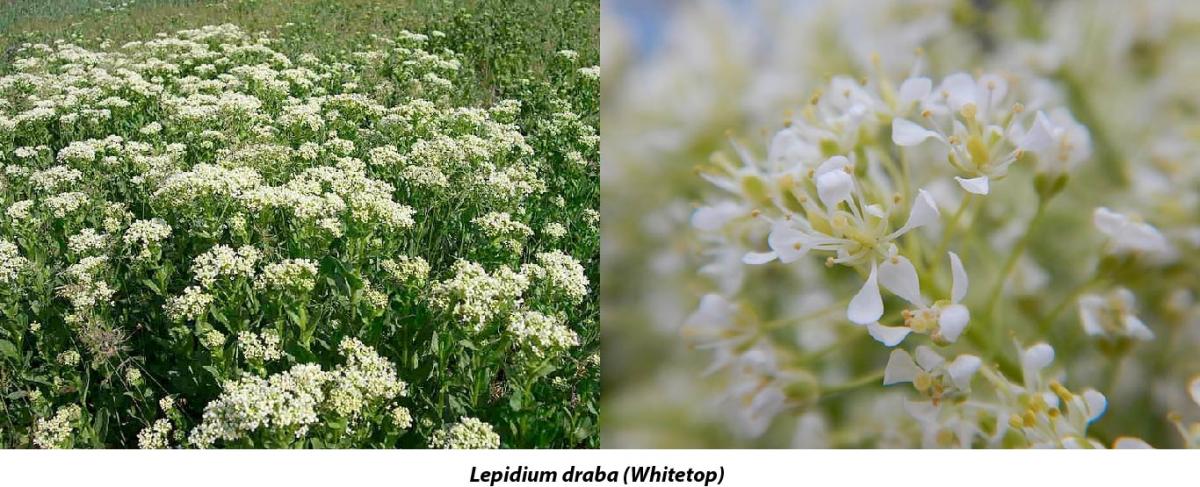
Flixweed
Flixweed (Descurainia sophia) is a common weed where I live and I’ve already seen patches of it growing this spring. I’ve tasted it and it has a nice mustardy flavor, but I never knew that it was medicinal. As I was looking into uses for various mustard family weeds, I discovered that this plant has been used in traditional herbal medicine around the globe.
Research shows it contains many bioactive compounds. It has been shown to have anti-inflammatory, antioxidant, anticancer, diuretic, febrifuge, analgesic, and antiparasitic activity. Clinical studies have documented that it can help with asthma, getting rid of intestinal worms, and has a tonic effect on the heart. It also may be helpful for cancer. The research also suggests it is a very safe remedy. I’ve got to experiment with this one too because it’s so plentiful here in Utah.
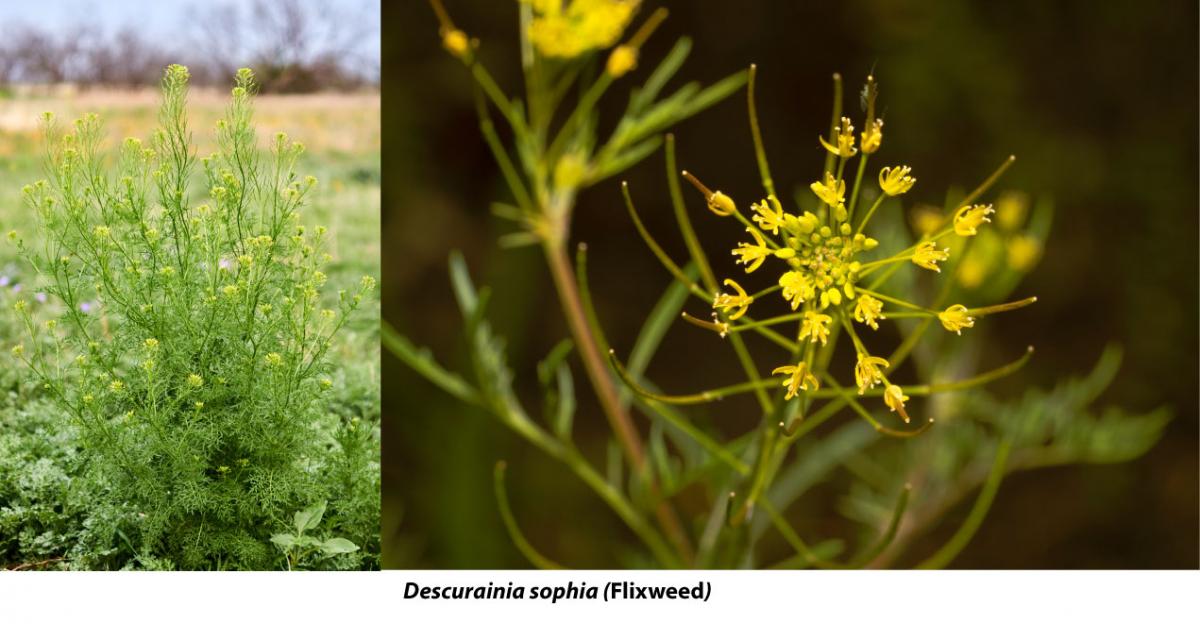
If you’d like to learn more about flixweed's uses, here are some resources.
- Therapeutic effects and mechanisms of actions of Descurainia sophia
- Flixweed: Descurainia sophia
- Descurainia sophia (L.): a weed with multiple medicinal uses
Many More Mustards
These are just a few examples of spring mustards you may find as you look around. Here are a few more quick examples.
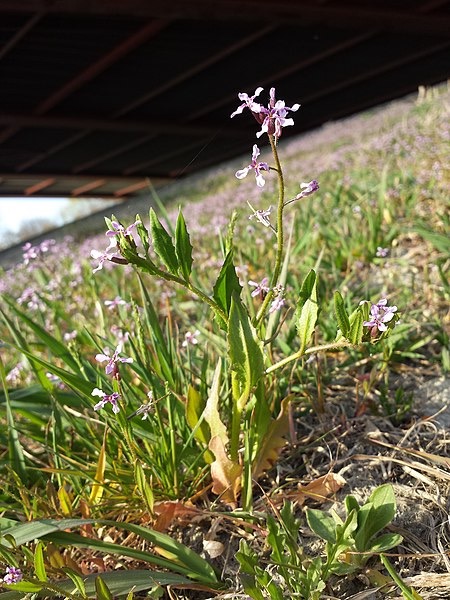 Blue mustard (Chorispora tenella) is a purple-flowered mustard that grows where I live. In fact, it’s growing right in front of my office. It’s a really tasty mustard, with a mild flavor that makes it suitable as a spring green for salads. It is pictured on the right.
Blue mustard (Chorispora tenella) is a purple-flowered mustard that grows where I live. In fact, it’s growing right in front of my office. It’s a really tasty mustard, with a mild flavor that makes it suitable as a spring green for salads. It is pictured on the right.
Tumble mustard (Sisymbrium altissimum) is another spring weed I see. It grows into a tumbleweed and is edible. It has a strong enough mustard flavor that it can be used like wasabi, which means it would have a decongestant effects and would probably aid sulfation. It’s closely related to a species called london rocket (S. irio) which has been grown as a vegetable and medicine. It also grows like a weed in much of the United States. It can be used for greens and helps to detoxify the liver and spleen, reduce swelling, and relieve congestion.
Field pennycress (Thlaspi arvense) also grows as a weed, but has been grown in gardens or used for sprouts. The young leaves, fruits, and seeds are edible and it has medicinal properties. It is anti-inflammatory, alterative, antibacterial, depurative, expectorant, and hepatic. The plant is known to draw out heavy metals and other soil contaminents from the environment, so it should only be harvested in clean areas. This suggests that it may also be a detoxifier for the body, helping the body to get rid of heavy metals and various chemicals.
I should also mention how I love to Pause and Eat the Shepherd's Purse when I see it. And don’t forget about more well-known mustards like radishes, watercress, and wild mustard, all of which are edible and have medicinal properties.
So, if you can look around and see what mustards you can find growing in your area. You may find some tasty snacks, salad greens, and even valuable herbal medicines.
Photo Credits
3. Peppergrass photos left to right
- Matt Lavin from Bozeman, Montana, USA, CC BY-SA 2.0, via Wikimedia Commons
- megachile, CC0, via Wikimedia Commons
- Bff, CC BY-SA 3.0, via Wikimedia Commons
- Natural Bridges National Monument, CC BY 2.0, via Wikimedia Commons
- Thayne Tuason, CC BY-SA 4.0, via Wikimedia Commons
- Matt Lavin from Bozeman, Montana, USA, CC BY-SA 2.0, via Wikimedia Commons
6. Blue mustard
- Stefan.lefnaer, CC BY-SA 4.0, via Wikimedia Common
Downloads
Steven's Articles
-

-
The Evidence for Berberine
A yellow alkaloid found in traditional infection-fighting…
-

-
The Sensible Use of Caffeinated Herbs
Kola nuts, guarana, and yerba mate and other herbs…
-

-
The Health Benefits and Problems with Coffee
This popular caffeinated beverage can be beneficial…
October
-

-
Understanding Caffeine & Cellular Adaptation
Preserving the power of caffeine's buzz and the…
September
-

-
Horseradish
A pungent spice for aiding protein metabolism…
-

-
Banaba or Crepe Myrtle
A beautiful tree from Southeast Asia whose leaves…
August
-

-
Monkeyflowers
Flower essences to help see ourselves more clearly…
-

-
Mariposa Lilies
Strengthening the bond between mother and child…
-

-
The Noble Bay Leaf
A common kitchen herb for aiding digestion and…
-

-
Epimedium: Horny Goat Weed
A circulatory stimulant and kidney yang tonic…
July
-

-
The Medicinal and Nutritional Benefits of Apricots
A nutritious fruit and valuable medicinal seed for coughs
-

-
Dogwoods
Asian dogwood is used to stop excessive discharge,…
June
-

-
Neem: The Village Pharmacy
A popular Ayurvedic remedy for dental and immune…
-

-
Spilanthes: The Toothache Plant
A traditional remedy for teeth and gums, as well…
-

-
Forsythia
An anti-inflammatory, fever-reducing, and infection fighting herb

